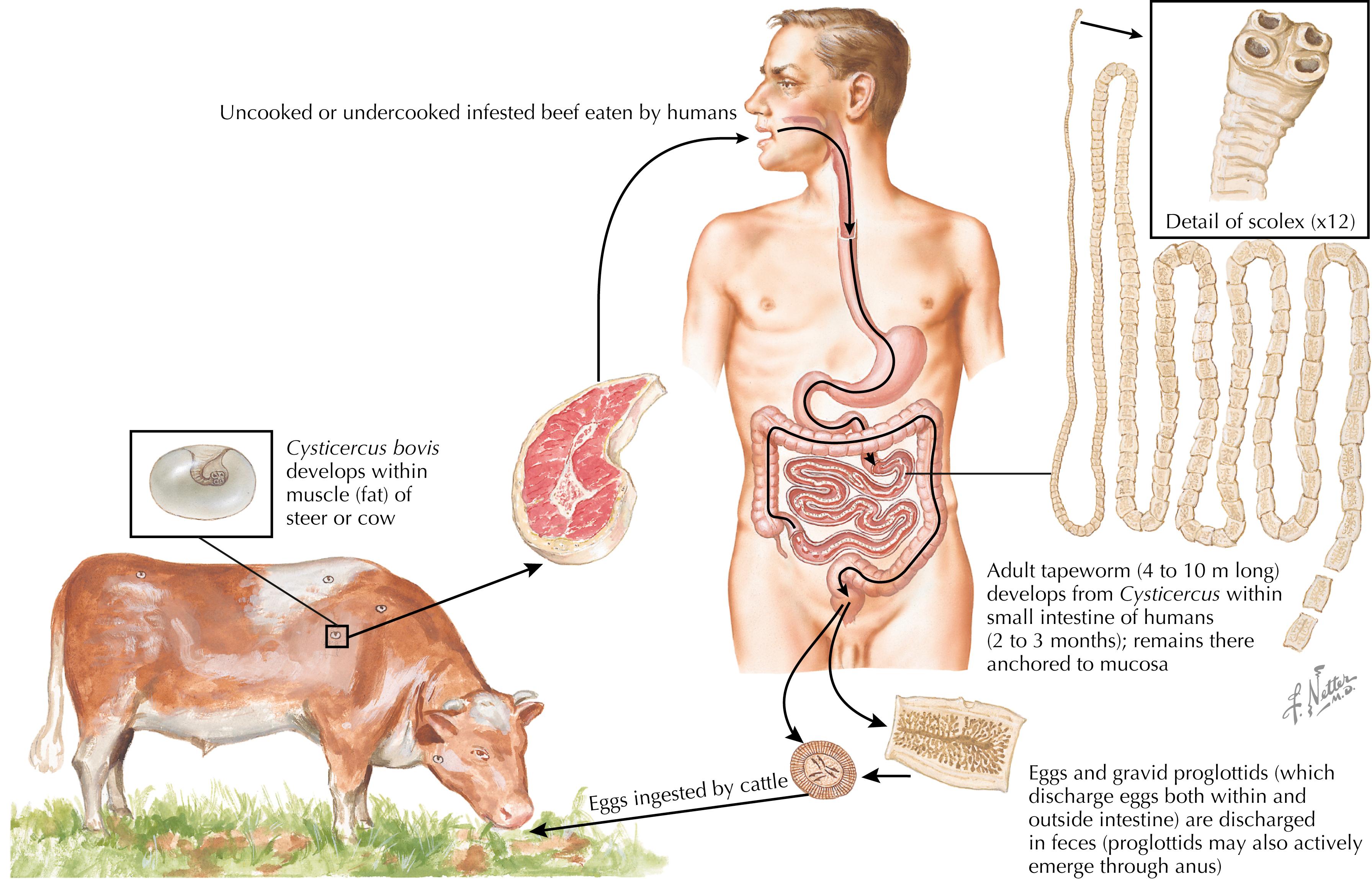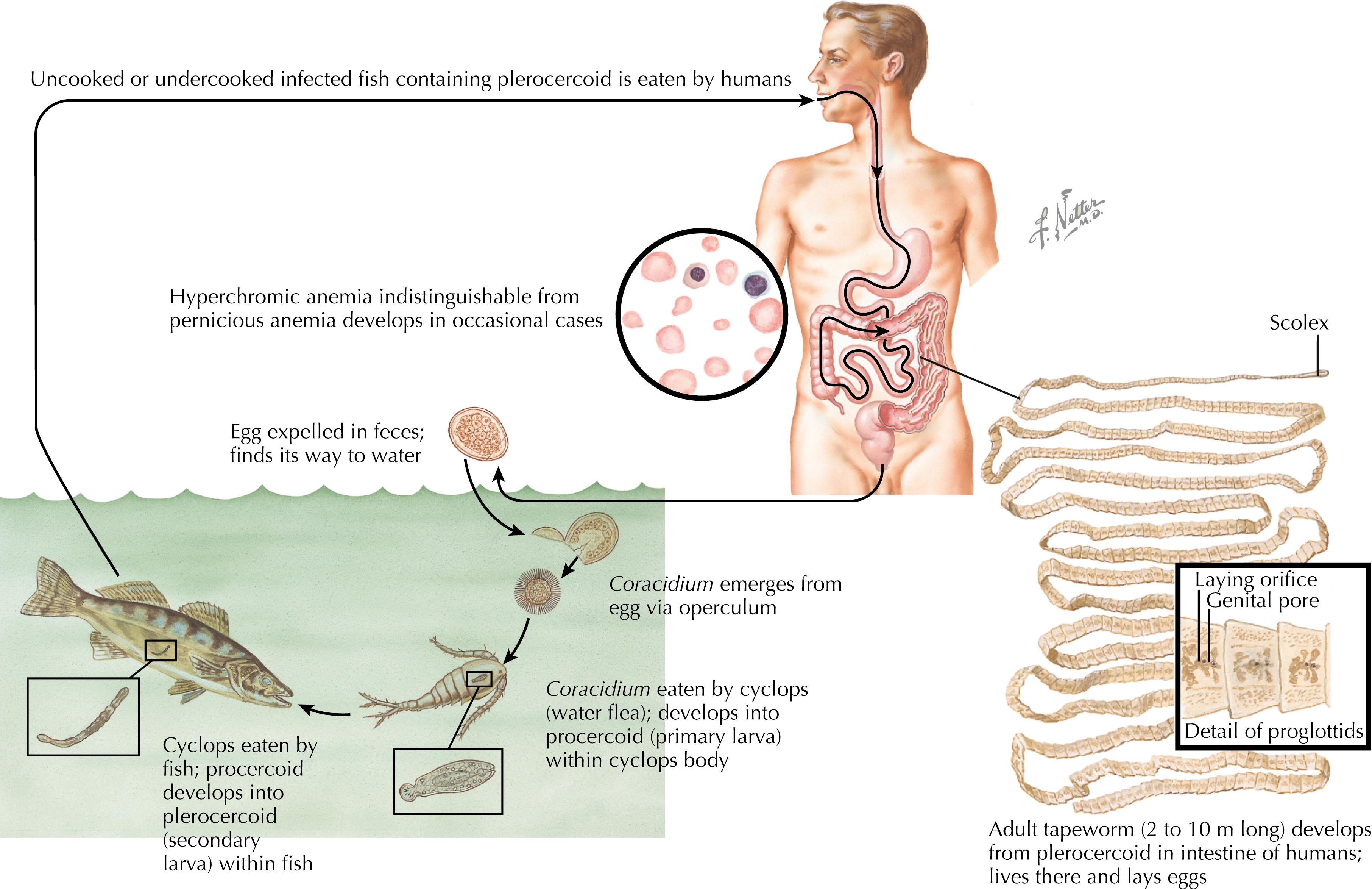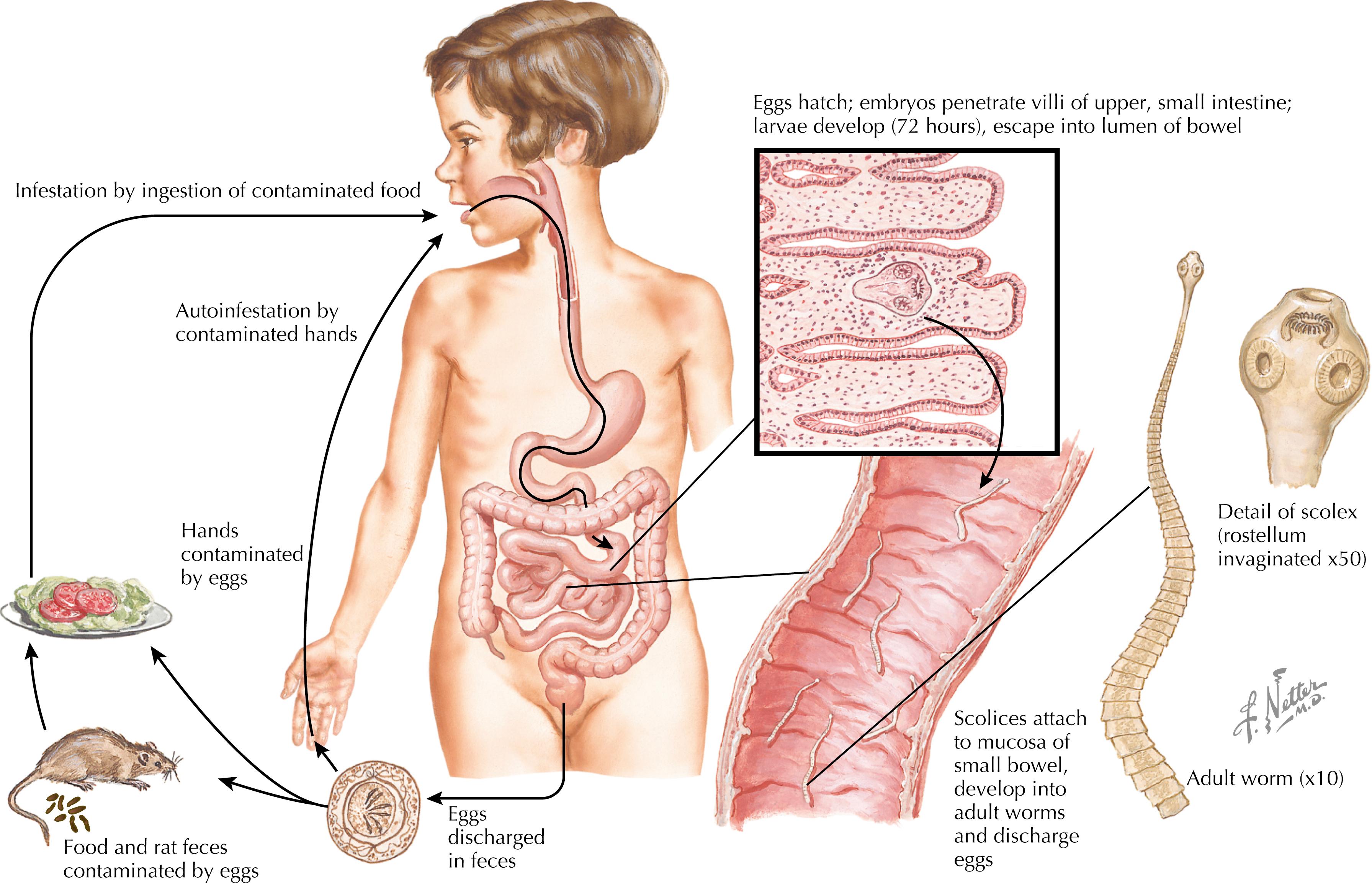Physical Address
304 North Cardinal St.
Dorchester Center, MA 02124
The relationship between humans and intestinal cestodes (tapeworms) goes well beyond the essential biologic interaction between host and parasite. Over time, tapeworms and tapeworm stories have contributed to human culture, literature, and dietary practices. In the late nineteenth century, part of the popular folklore was that a tapeworm infection could help make one thin, and tapeworm eggs were actually advertised commercially as a weight reduction aid. On the other hand, one of the well-known clinical manifestations of intestinal tapeworm infection is the passing of grossly visible ribbons or tapes (strobilae) of worm segments (proglottids), often alive and wriggling, from the anus of the human host, leading to considerable reaction in the infected person.
Human tapeworm infections usually result from food-borne transmission when raw, smoked, pickled, or undercooked pork, beef, or fish infected with larval stages of tapeworms are ingested. Pork (Taenia solium) , beef (Taenia saginata) , and fish (Diphyllobothrium latum) tapeworms account for the majority of human infections, but human infections with the rodent tapeworms Hymenolepis nana and Hymenolepis diminuta and the dog tapeworm Dipylidium caninum may occur after inadvertent ingestion of contaminated insect intermediate hosts. Invasive systemic diseases in humans caused by tapeworm infections such as cysticercosis (caused by T. solium ) and cystic and multilocular echinococcosis (caused by Echinococcus granulosus and Echinococcus multilocularis , respectively) are addressed in separate chapters (see Chapter 45 and Chapter 85 ).
Intestinal tapeworm infections are rare in the general population of economically advanced countries but cause significant human morbidity and economic losses in the meat industry in regions where personal and environmental hygienic practices and regulatory controls are insufficient. Recently, however, with the emergence of a global food market, salmon aquaculture has been associated with the transmission of fish tapeworm infections thousands of miles beyond the region of original fish production. Similarly, it is possible that international meat markets could contribute to food-borne beef and pork tapeworm infections outside of known endemic regions, especially if breakdowns occur in regulatory infrastructure or meat inspection procedures.
A colleague asks you about a 4-year-old child who has been treated many times for pinworms with over-the-counter medication by his mother, but she still sees worms in his stools and he complains of having an itchy backside. The mother is a working mom, and the child stays with his grandparents during the day and sometimes on weekends. The family lives in a poorer area of town where the housing is known for poor maintenance by the property owners. The mom has pictures on her phone of the worms she is seeing. The child is seen and is generally well nourished, with no evidence of chronic illness. The photographs show white glistening “things” not clearly discernable as worms and could just be mucus. Pinworm paddles are requested, and you ask the mom to catch some of the worms using the paddles, then place the paddles in a transport vial containing SAF (sodium acetate-acetic acid-formalin) ova and parasite fixative and specifically ask the laboratory to look for “worms.” You consider treating with mebendazole for pinworms again but decide to wait for the parasitology results. Diagnosis: Dipylidium caninum. The mother was horrified when you described the life cycle and how her son probably got infected. Treatment with praziquantel was effective.
Patients with the chief complaint of “passing a tapeworm” or with signs and symptoms of heavy worm burdens (vague abdominal discomfort, perianal irritation, anorexia, eosinophilia) are uncommon in most developed countries unless there is a history of specific risk, such as international travel, dietary exposures, migration, occupation, or certain circumstances of socioeconomic deprivation. Table 80.1 summarizes the geographic distribution and usual clinical features of the tapeworms infecting humans.
| Parasite Name | Endemic Geographic Parasite Distribution | Common Clinical Significance |
|---|---|---|
| Tapeworms With Humans as the Definitive Host (Sexual Reproduction of the Parasite) | ||
| Taenia saginata | The beef tapeworm is common in cattle-breeding regions worldwide. Humans are the definitive host and cattle the intermediate host. Areas with the highest (i.e., >10%) prevalence are central Asia, Near East Asia, and Central and Eastern Africa. Areas with low (i.e., 1%) prevalence are Southeast Asia, Europe, and Central and South America. Prepatent period: 3–5 months Lifespan: up to 25 years Length of worms: 4–8 m |
Adult tapeworms live in the gastrointestinal tract of the human host. Eggs are excreted in the stools, and motile tapeworm segments can also be expelled from the bowels. The beef tapeworm does not cause invasive disease in humans but must be distinguished from the pork tapeworm, which does cause tissue infections in people, in regions where their distribution overlaps. People of all ages and races and both genders are susceptible to infection, which is acquired by eating larvae-infected undercooked beef meat. |
| Taenia solium | The pork tapeworm is endemic in Central and South America, Southeast Asia, India, the Philippines, Africa, Eastern Europe, and China, with humans being a definitive host and pigs the intermediate host. Areas of highest prevalence include Latin America and Africa. In some regions of Mexico, the prevalence of infection may reach 3.6% of the general population. Prepatent period: 3–5 months Lifespan: up to 25 years Length of worms: 3–5 m |
Adult tapeworms live in the gastrointestinal tract of the human host. Eggs are excreted in the stools, and motile tapeworm segments can also be expelled from the bowels. In humans, the pork tapeworm causes invasive disease affecting soft tissues and the brain (cysticercosis). People of all ages and races and both genders are susceptible to infection, which is acquired by eating larvae-infected undercooked pork meat or by ingesting food contaminated with pork tapeworm eggs. |
| Diphyllobothrium latum | In North America, fish tapeworm infections have been previously reported in fish from the Great Lakes. There are six Diphyllobothrium species known to reside in Alaskan lakes and rivers, and some saltwater species may also be seen in North America. Diphyllobothrium infections are not species specific, and widespread reports describe infection in North American fish-eating birds and mammals. Humans are a definitive host, and crustaceans followed by fish are intermediate hosts. The incidence in the United States has been declining recently. Pike, perch, and salmon are among the fish most commonly infected. Reports are commonly made of D. latum infection in humans residing in Europe, Africa, and the Far East. Prepatent period: 3–5 weeks Lifespan: up to 25 years Length of worms: 4–10 m |
Adult tapeworms live in the gastrointestinal tract of the human host. Eggs are excreted in the stools, and motile tapeworm segments can also be expelled from the bowels. The fish tapeworm does not cause invasive disease but, because of its length and potential to interfere with vitamin B12 absorption, can cause a number of nonspecific symptoms. People of all ages and races and both genders are susceptible to infection, which is acquired by eating undercooked, infected fish flesh. People preparing fresh fish, implements used to prepare fish (e.g., knives and cutting boards), and raw or undercooked fish meals (e.g., sushi, sashimi, ceviche) may be associated with a higher risk of infection. |
| Tapeworms With Humans as Inadvertent or Unnatural Hosts (Sexual Reproduction of the Parasite Normally Occurs in Another Animal Species) | ||
| Hymenolepis nana | H. nana (dwarf tapeworm) is a cosmopolitan intestinal tapeworm usually infecting rodents, mice, or rats. The intermediate host, a beetle, is not required to complete its life cycle in definitive hosts. Ingestion of tapeworm eggs by a definitive host, including humans, can reestablish an adult tapeworm infection. Prepatent period: 2–3 weeks Lifespan of infection: many years because of autoinfection. Length of worms: 2.5–4 cm |
Often associated with environments with poor sanitation, the dwarf tapeworm causes few clinical problems; signs and symptoms include nonspecific abdominal complaints, loosening of the stools, perianal irritation, and the possible presence of small motile segments visible in the stool or on undergarments. |
| Dipylidium caninum | D. caninum is a cosmopolitan tapeworm infection of dogs, with inadvertent human infections occurring through ingestion of the intermediate host, a flea that has fed on the tapeworm eggs contaminating the animal’s fur or dog feces. Human infections have been reported in Europe, the Philippines, China, Japan, Argentina, and North America. Prepatent period: 3–4 weeks Lifespan: Less than 1 year. Length of worms: 10–70 cm |
Adult tapeworms live in the gastrointestinal tract of the inadvertent human host, usually a child. Perianal irritation may occur, with the passage of motile segments of the tapeworm or small “grain of rice”-like motile segments that may be seen in the stools. The proglottids are motile when passed and may be mistaken for maggots or fly larvae. |
| Hymenolepis diminuta | The rat tapeworm requires a grain beetle as an intermediate host, so it is most common in grain-producing areas of the world or where grain or other dry foods are stored. Human infections are uncommon. Prepatent period: 3 weeks Lifespan: less than 1 year Length of worms: 20–60 cm |
Often associated with environments with poor sanitation, the rat tapeworm rarely infects humans and causes few clinical problems; these include nonspecific abdominal complaints, loosening of the stools, and perianal irritation and the possible presence of small motile segments visible in the stool or on undergarments. |
Humans serve as definitive hosts for beef and pork tapeworms; ingested larvae mature to sexually mature adult forms, and parasite eggs are produced in the small intestine. The eggs are excreted in the feces of the human host. Intermediate hosts ingest the eggs when human waste is deposited indiscriminately in the environment. On ingestion, the eggs develop into infective larvae in the tissues of the intermediate host. The reproductive life cycle is completed when humans ingest the infected intermediate hosts ( Fig. 80.1 ; Fig. 81.3 ). In the case of Diphyllobothrium species (fish tapeworms), larval stages in two intermediate hosts are involved. The interdependence of the parasite on human definitive hosts and nonhuman intermediate hosts is complex ( Fig. 80.2 ).


The rodent tapeworm infection caused by H. nana ( Fig. 80.3 ) deserves special attention. It is one of very few helminthic (worm) infections of humans that can complete its entire life cycle in the human host without an obligate life stage in an intermediate host. Thus H. nana can cause auto-infections, resulting in a persistently infected state, heavy worm burdens in a given individual, and the possibility of direct human-to-human infections. Other important helminthic infections with a potential auto-infective cycle are the nematodes Strongyloides stercoralis (see Chapter 79 ), Enterobius vermicularis (see Chapter 79 ), and Capillaria philippinensis . H. nana infections are most commonly found in children living in dire socioeconomic conditions where rodent feces contaminate the environment and foodstuffs, leading to inadvertent oral exposure. The usual life cycle involves an infected rodent (definitive host) excreting eggs that are ingested by a beetle (intermediate host) where the larval forms develop; when a rodent eats the infected beetle, the larvae mature to adults, and ultimately infective eggs are excreted into the environment, thus reestablishing an infection in another beetle. Neither the usual definitive hosts nor intermediate hosts are obligate requirements for the completion of this life cycle. Upon the ingestion of infected rodent feces, humans can serve as an inadvertent definitive host without the requirement of the intermediate beetle host, or humans can become reinfected by swallowing H. nana eggs passed in their own feces.

Intestinal infections with other animal tapeworms D. caninum or H. diminuta are sporadically detected in otherwise healthy persons. Infection occurs after the inadvertent ingestion of infected fleas (D. caninum) or grain beetles ( H. diminuta ; see Table 80.1 ).
Most human intestinal tapeworm infections are asymptomatic until a proglottid, a longer chain of proglottid segments (strobila), or the entire adult tapeworm is passed out of the bowel. Each of these living worm components can be motile; thus the presence of the tapeworm is often manifested by a patient’s complaint of the sensation of wriggling in the perianal region or undergarments. Pernicious anemia caused by vitamin B 12 deficiency is a rare complication of fish tapeworm (Diphyllobothrium) infections. Complications of tissue invasion with larval forms of tapeworms are addressed elsewhere (see Chapter 81 and Chapter 85 ). Multiple adult tapeworm infections and infections with multiple species of intestinal tapeworms in a single individual at the same time are uncommon clinical phenomena.
Become a Clinical Tree membership for Full access and enjoy Unlimited articles
If you are a member. Log in here